A FAIR study found that CNN’s primetime coverage of the Los Angeles anti-ICE protests in early June rarely included the voices of the protesters themselves. Instead, the network’s sources were overwhelmingly current and former government and law enforcement officials. The resulting coverage rarely took issue with Trump’s desire to silence the people who were defending their undocumented neighbors—but mainly debated his decision to deploy the California National Guard to do so.
FAIR recorded the sources that appeared in the 5–10 pm timeslot during two key days, June 9 and 10, of CNN’s television coverage of the Los Angeles protests; the shows included were the Lead with Jake Tapper, Erin Burnett OutFront, Anderson Cooper 360 and the Source With Kaitlan Collins.
The sources were categorized by current or former occupation, and on whether they were a featured guest—who typically field multiple interview-style questions from an anchor—or simply a soundbite. Sources that made multiple appearances were counted once for each segment they appeared in. (CNN’s in-house “analysts” or “commentators” were counted as featured guests to reflect their significant impact on the perspectives shared on the shows.)
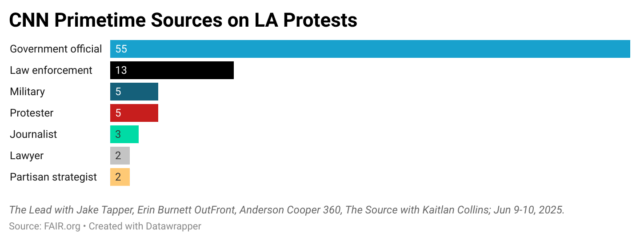
Out of 85 total sources across the eight broadcasts, only five were protesters, appearing on just three shows. None of the 47 featured guests were protesters or community or immigrant advocates.
By far the most frequent sources were current or former US government officials, with 55 appearances—a whopping 65% of total sources. Thirteen additional sources were law enforcement, and five were current or former military. Together, these official sources accounted for 86% of all appearances. (There were also three journalists, two lawyers and two partisan strategists.)
Of featured guest and analyst interviews, current or former government officials dominated at 49% (23 out of 47). These sources were given the most time to present their perspectives, shaping the narrative around the protests and the government responses. Another 11 featured guests were law enforcement and two were military, so official sources accounted for 77% of all such interviews. The three journalists, two lawyers and two partisan strategists made up the remaining featured guests.
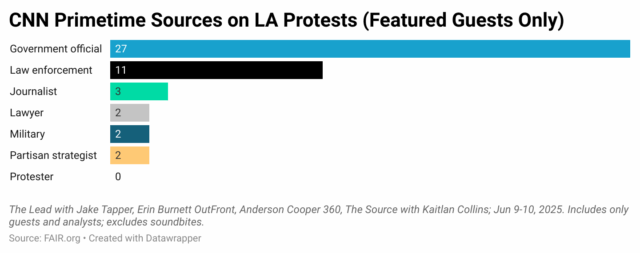
‘Verbally at least hostile’
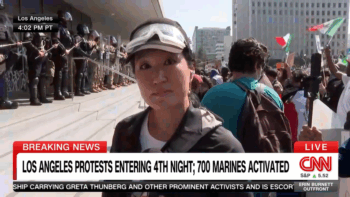
CNN‘s Kyung Lah (6/9/25) covers protests at LA’s Federal Building—while giving no sign of talking to any protesters.
CNN’s made-for-TV, on-the-ground style of protest coverage in the days following the Ambiance Apparel and Home Depot ICE raids felt little different from when Anderson Cooper stands around in a raincoat during a hurricane. Only this time, CNN reporters were braving an uncontrollable storm of Angelenos.
Much like Cooper’s coat, CNN senior investigative correspondent Kyung Lah (Erin Burnett OutFront, 6/9/25) donned protective goggles—useful should she have encountered tear gas, but also undoubtedly a dramatic flourish perfect for one of CNN’s 30-second TV spots.
That CNN was primarily interested in drama rather than helping viewers understand the protests became abundantly clear as—even with her protective goggles—Lah made no apparent effort to interview any protesters as she and CNN anchor Erin Burnett stood in front of LA’s federal detention center, where federal agents, LAPD and the California National Guard were in a standoff with demonstrators. Instead, they kept a close eye on every thrown water bottle, expressing concern about the crowd’s increasingly “young” demographic as the day went on. “This is a much younger crowd, certainly, verbally at least, Erin, hostile,” Lah reported.
The only protest voices that CNN’s audience heard from throughout both days of primetime coverage came in the form of two brief soundbites captured by correspondent Jason Carroll (Lead, 6/9/25) at a protest for the release of arrested SEIU leader David Huerta the morning of June 9.
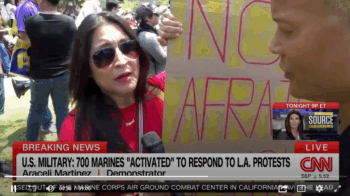
Araceli Martinez, the only named protester in the study period with a soundbite on CNN ( 6/9/25).
Araceli Martinez, the only protester identified by name, offered a call to action for all Americans, arguing that the Trump administration’s immigration raids are a threat to “the rights of all people, not just the immigrants, but all of us.” That soundbite reaired on Erin Burnett Outfront and Anderson Cooper 360, both on June 9.
Another protester at the demonstration demanding Huerta’s release had this to say, with the soundbite reairing on Anderson Cooper 360, also on June 9:
We are part of that immigrant community that has made L.A. great, that has made the state of California the fourth largest economy in the world today. So, we have a message for President Donald Trump. Get the National Guardsmen out of here.
Multiple times during the first day studied, Lah held up that union-led protest as a standard of message discipline and nonviolent tactics that those outside the federal building, later in the day, weren’t measuring up to. The folks at the earlier protest were “a very different slice of Los Angeles than what I am seeing” at the federal building, Lah said. The key word there is “seeing,” as she did not interview a single protester on camera.
‘We do very good here with unrest’
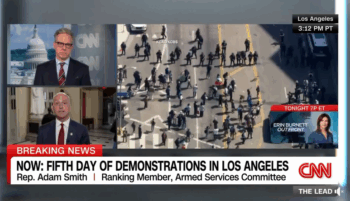
CNN‘s Jake Tapper (6/10/25) interviews Rep. Adam Smith, who agrees that “you should meet any sort of violent protest with law enforcement.”
Meanwhile, CNN brought on multiple featured guests who framed protesters as violent and law enforcement as the ones pushing for accountability—despite the fact that reported injuries of civilians by law enforcement far outnumbered those of law enforcement by protesters (FAIR.org, 6/13/25). LA District Attorney Nathan Hochman (OutFront, 6/10/25), for example, stated that he would work to “punish” all protesters who engage in “illegal conduct.”
Similarly, California Lt. Gov. Eleni Kounalakis (Source, 6/10/25) warned “anyone who goes out and is protesting in a way that is not peaceful…state and local and regional law enforcement will hold people accountable.”
Rep. Adam Smith told Jake Tapper (Lead, 6/10/25): “I don’t disagree that you should meet any sort of violent protest with law enforcement, but there’s no evidence in this case that the LAPD wasn’t doing that.” Once you parse the double negatives, it’s clear that Smith, like the rest of CNN‘s official sources, accepted the characterization of protesters as violent and argued that the response of California law enforcement was perfectly appropriate.
Most of these state and local government sources were responding to questions about Trump calling in the National Guard and Marines; they were defending the local law enforcement response and challenging Trump’s decision.
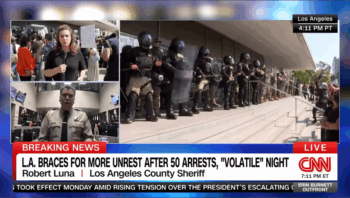
CNN‘s Erin Burnett (6/9/25) interviews LA County Sheriff Robert Luna, who assures her his forces were “very good here with unrest.”
One of Burnett’s featured guests, for instance, was LA County Sheriff Robert Luna (OutFront, 6/9/25)—the leader of a police force that community activists say routinely collaborates with federal immigration raids (Democracy Now!, 6/9/25), and had just sparred with demonstrators in the Home Depot parking lot in Compton following the failed ICE raid there (New York Times, 6/14/25).
The primary focus of Burnett’s line of questioning was geared at exposing the political nature of Trump’s calling in the national guard:
Just a very simple question. Do you need the Marines? Do you need the National Guard right now? Or if you were looking at this situation and assessing it as sheriff of LA County, would you say you do not need them?
That’s certainly a critical line of questioning to get at the issue of federal overreach. But Burnett failed to similarly question (or even acknowledge) the violence by local law enforcement—which, by the time of Burnett’s broadcast, included 24 attacks on journalists with weapons like pepper balls, rubber bullets and tear gas canisters, according to Reporters Without Borders (FAIR.org, 6/13/25).
Instead, she left unchallenged Luna’s claims that “if they’re peacefully protesting, they’ll be allowed to do that,” that his utmost priority was “keeping our community safe,” and that his police force does “very good here with unrest.”
In doing so, Burnett framed the story as a question of whether putting down protests against sweeping raids of undocumented workers was the responsibility of federal troops or local law enforcement—rather than questioning why such protests were being met with force, and why local officials weren’t doing more to protect their immigrant communities.
Redefining safety
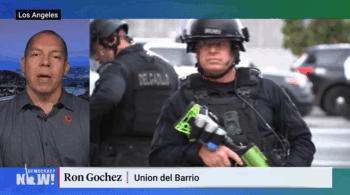
Democracy Now! (6/9/25) broadened the conversation by allowing protesters like Ron Gochez to take part in it.
Meanwhile, the protesters that received such little consideration from Burnett and CNN could have contributed to a very different definition of safety for CNN’s viewers. Ron Gochez, a community organizer and social studies teacher, who was one of the protesters at the ICE raid on Ambiance Apparel, described on Democracy Now! (6/9/25) how the protests have managed to protect people despite the efforts of local and federal officials:
When we have these protests, they have been peaceful. But when the repression comes from the state, whether it’s the sheriffs, the LAPD or, on Saturday, for example, in Paramount, California, it was the Border Patrol, it was brutal violence….
But what they didn’t think was going to happen was that the people would resist and would fight back. And that’s exactly what happened in Paramount and in Compton, California, where for eight-and-a-half hours, the people combatted in the streets against the Border Patrol…. They had to retreat because of the fierce resistance of the community. And the hundreds of workers that were in the factories around them were able to escape. They were able to go to their cars and go home. That was only thanks to the resistance that allowed them to go home that night.
The Trump administration is intent on testing just how far it can go to crush political dissent, and it’s clear most Democratic politicians and local law enforcement are not going to bat for the most vulnerable communities in its crosshairs. Angelenos know they are fighting for the rights of all of us who reside in the US. But CNN’s refusal to have them on air to discuss their struggle and explain their tactics makes it all the more difficult to raise public awareness. Pretending to challenge the deployment of federal troops, CNN normalizes police violence and silences those truly protecting their communities.
This content originally appeared on FAIR and was authored by Luca GoldMansour.